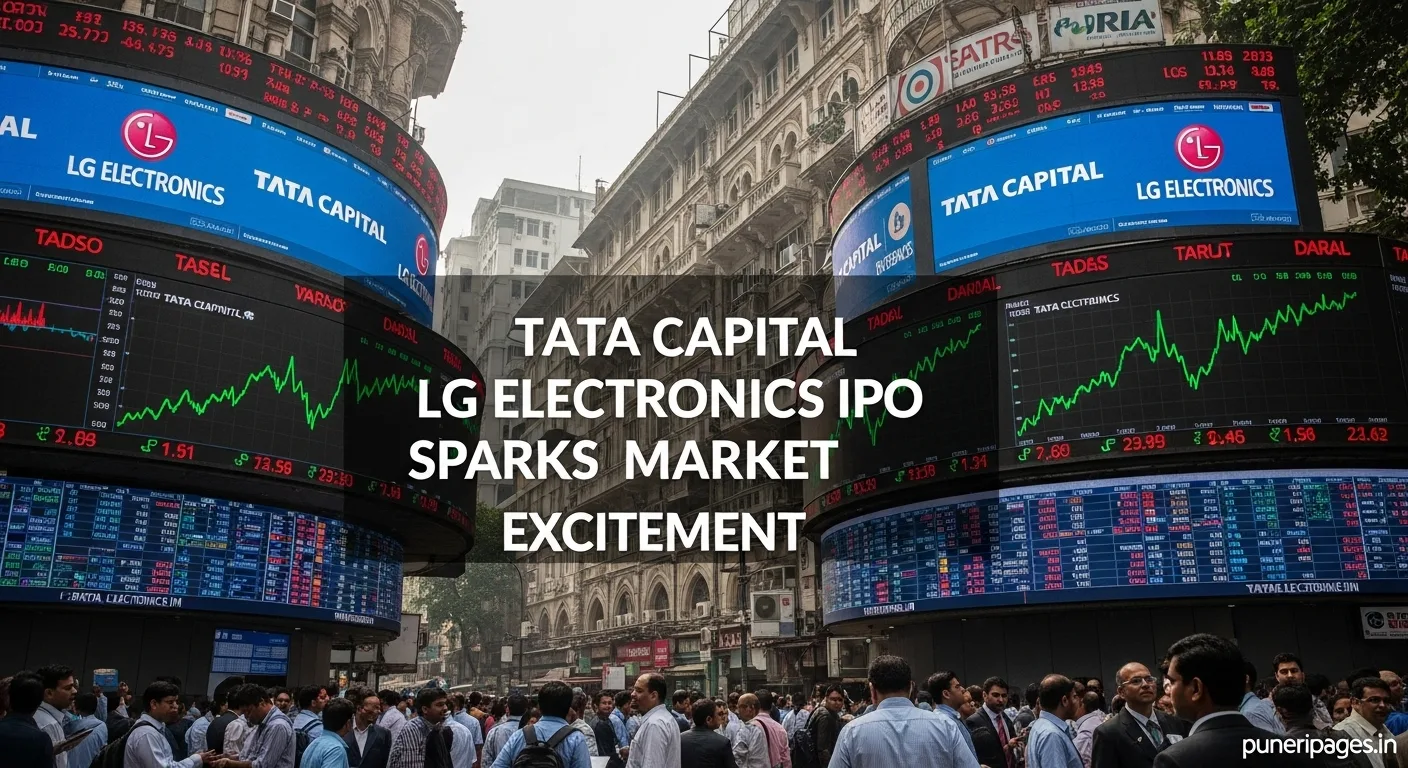
Tata Capital LG Electronics IPO leading India’s ₹30,000 crore market surge on Dalal Street.
By Prashant for PuneriPages.in
The Indian primary market is witnessing a spectacular wave of initial public offerings, with Tata Capital and LG Electronics spearheading a record-breaking ₹30,000+ crore IPO week. As these marquee listings prepare to debut, investors, analysts, and policymakers are watching closely—this could shape the trajectory of India’s equity markets through the remainder of 2025 and beyond.
Table of Contents
India’s Mega IPO Week: Scale and Significance
The scale of the current IPO frenzy is staggering. In one week, as many as seven companies are launching offerings totaling over ₹30,000 crore on Dalal Street. Among them, Tata Capital’s mammoth ₹15,512 crore IPO and LG Electronics’ ₹11,607 crore listing stand out as the anchors of this market surge.
What’s especially intriguing is how these two giants—one from financial services, the other from consumer electronics—have converged in the spotlight, broadening the appeal of this IPO jam. The resulting mix of sectoral diversity and sheer magnitude is reshaping investor sentiment and fueling renewed confidence in India’s capital markets.
Tata Capital’s IPO: Key Details & Market Buzz
Structure and Scope
Tata Capital’s IPO is structured in a hybrid model, combining a fresh issue of 21 crore shares (worth ~₹6,846 crore) and an Offer for Sale (OFS) of 26.58 crore shares (worth ~₹8,665 crore) by existing stakeholders. The total issue size is pegged at ₹15,512 crore.
Pricing & Valuation
The IPO price band is fixed at ₹310–₹326 per share. Based on this band, the implied valuation of Tata Capital ranges from ₹1.31 lakh crore to ₹1.38 lakh crore. Interestingly, this pricing is significantly lower than its unlisted share price, where shares have reportedly been trading above ₹700. This discount has raised eyebrows among market watchers who expected a closer alignment.
Listing Timeline & Subscription
The IPO is open for subscription from October 6 to 8, 2025. Final allotment is expected on October 9, refunds on October 10, and listing on October 13. Retail investors can bid starting with lots of 46 shares, requiring a minimum investment of ₹14,260.
Analyst Views & Risks
Brokerages show optimism, citing the strong Tata brand, diversified NBFC business lines, and robust financials. Still, key risks include the steep discount to unlisted valuations, volatility in the grey market premium (GMP), regulatory challenges (given NBFC listing mandates), and possible interest rate headwinds.
Notably, the company has already secured ₹4,641 crore from anchor investors, with LIC emerging as the largest buyer. Anchor allocation was largely at the upper price band—indicating confidence from institutional players.
LG Electronics IPO: Tech Giant Joins the Party
LG Electronics India is not far behind. Its IPO opens between October 7 and 9, entirely as an Offer for Sale by its parent company, priced in the band ₹1,080–₹1,140 per share. Unlike Tata Capital, LG’s IPO will not raise fresh capital—entire proceeds go to the parent. Analysts see a strong grey market premium (GMP) already (up to 20%), pointing to high listing expectations.
Valuation expectations suggest LG India may be priced between ₹77,000 crore to ₹1 lakh crore depending on demand and oversubscription.
Why This IPO Wave Matters More Than Just Size
Market Sentiment & Confidence
The sheer magnitude of these IPOs signals strong investor confidence in India’s capital markets. After a lull, this wave could reignite broader funding activity across sectors.
Sectoral Diversification
This batch spans finance (Tata Capital), consumer electronics (LG), real estate, technology, and more—spreading risks and attracting different investor cohorts.
Regulatory & Structural Impact
Tata Capital’s listing is partly driven by RBI’s mandate for “upper layer” NBFCs to list by September 2025 unless exempted. That has pushed many NBFCs to accelerate IPO plans. LG’s listing, though an OFS, brings global brand gravitas to India’s markets.
Timing & Festive Tailwinds
This IPO wave aligns with India’s festive season (Diwali), when investor appetite is traditionally higher. Launching across October adds both symbolic and momentum value.
Challenges & Watchouts
- Grey Market Volatility: GMP fluctuations can distort expectations, sometimes disconnecting perception from fundamentals.
- Policy Risk & Interest Rates: Rising rates or regulatory changes could cool down enthusiasm.
- Valuation Gaps: Significant discount between unlisted and IPO valuations may deter skeptical investors.
- Overcrowding Risk: With 7 IPOs in one week, oversubscription and subscription fatigue could emerge.
Investor Strategy: Navigating the IPO Storm
- Focus on fundamentals: Don’t rely solely on hype or grey market signals—understand balance sheets, growth prospects, and the strength of business models.
- Diversify cautiously: With multiple high-ticket listings, spreading allocations can enhance risk-adjusted returns.
- Use limit orders in volatile debut: Avoid market highs with smart order placement.
- Watch lock-ins & allotments: Anchor investor holdings, lock-in periods, and share allotment rules will affect early supply.
- Stay updated on allotment status: Be ready to react quickly to listing day dynamics and secondary opportunities.
Conclusion: A Defining Week for India’s IPO Landscape
This week marks a pivotal chapter in India’s capital market history. Tata Capital’s colossal IPO and LG Electronics’ global branding are not just headline-grabbers—they are catalysts reshaping the momentum and structure of listings. As ₹30,000+ crore is deployed across seven IPOs, success here could pave the way for even greater fundraising waves in 2026.
But execution, demand, and market discipline will determine lasting success. Investors and regulators alike will scrutinize how these offerings perform, set precedents, and anchor market expectations for years to come.






